We live in a networked age. After centuries of perceiving different parts of the world as separate and isolated, we are now beginning to see our planet as an interconnected system. This shift in awareness has played a key role in shaping the context in which we operate today. By looking at systems as a whole, network sciences produced more efficient transportation and communication systems and led to the rise of ecology as the study of biological interconnectedness. Early applications of network thinking supported the development of the Internet — something that continues to expand at an enormous rate.
Network thinking has brought about vast improvements in efficiency in all these sectors. But while such ideas have had an enormous impact on technology, we have yet to see comparable gains in understanding social systems. Social networking software and websites such as MySpace claim to provide a meaningful way to bring people together from around the world in virtual communities. However, these Internet-based solutions have gained a negative reputation for harboring child predators and others who take advantage of the web’s anonymity to deceive their victims. The purpose of this article is to introduce the history, scientific theory, and research behind how true value is created in social networks — and to provide ideas for starting to leverage this knowledge for the good of organizations and beyond.
TEAM TIP
When making changes to a team structure, look beyond people’s official roles to see how work is actually being accomplished. Otherwise, you risk disrupting value-creating social networks, something that can undermine group productivity.
Not in My Space!
Over the past few years, social networking websites have exploded seemingly out of nowhere. MySpace, which was founded less than four years ago, now has more than 100 million users. PC Magazine defines social networking as “a web site that provides a virtual community for people interested in a subject. It provides a way for members to communicate by voice, chat, instant message, videoconference and blogs.” The use of social networking software to form relationships online is a logical extension of the Internet’s communication capabilities. All indicators suggest that social networking providers will continue to flourish, even as new technologies emerge that improve virtual connections, such as Web 2.0 (web-based communities and hosted services that facilitate collaboration and sharing between users) and telepresence services.
But the popularity of existing services is being shadowed by concerns of child predation and social deception. Four families are suing MySpace after their underage daughters were sexually abused by adults they met through the site. Congress introduced the Deleting Online Predators Act of 2006, and although it did not pass the Senate, it is likely to be considered again by the 110th Congress.
Beyond concern over legal liability for the actions of people who use their services for criminal purposes, technology companies need to take into account their brand image. Over the long run, those that allow antisocial behavior to flourish — even if it’s through benign neglect — will likely be less successful than those who promote social well-being. In an ever-more crowded marketplace, the adoption of socially responsible technologies will become an important new competitive differentiator.
While technologies such as MySpace claim to be novel social networking solutions, the science of studying and understanding social networks has been developing for at least 100 years. By applying this rich body of work to the business world, I have found that value is created in collaborative social systems that run across a company’s traditional organizational chart. Enterprises that learn how to create an environment that accelerates the functioning of such networks through mutual acceptance, respect, and co-inspiration will realize large gains in performance and the well-being of their workforce. While current social networking technologies are likely to become passé as new technologies emerge, our understanding of social networks will become a core competency for organizations that find themselves in an integrated global economy.
Social Network Mapping vs. Social Network Analysis
The father of social network measurement was J. L. Moreno, M. D., an Austrian gestalt psychiatrist who, in 1915, began charting social relations by drawing “sociograms” that showed group relations as line drawings connecting people. In developing “sociometry,” now referred to as social network mapping, Moreno sought to study social groups in order to recognize and acknowledge the value of each person. Moreno was influenced by George Herbert Mead, who developed qualitative research methods, and by the American educator John Dewey. Dewey saw individuals as inseparable from their social context, just as society is meaningless apart from its realization in the lives of its individual members. Additionally, just as Dewey influenced W. E. Deming and Walter Shewhart in the creation of continuous quality improvement processes, he also influenced Moreno to use social measurement as an action science to continuously improve social well-being.
Sociologists and anthropologists use social network measurement to uncover the overall structure of a social system. In this context, a system can be small, like a family or a manufacturing line, or large, like trade balances among nations. With this knowledge of the interrelationships and social rules in a given culture, social scientists can better understand, for instance, the spread of HIV, with the goal of stopping the epidemic.
Analysis is defined as the decomposition of the whole, so social network analysis, as practiced today, generally focuses on individuals and their roles. For example, someone with many more social connections than others might be described as a “hub.” In contrast, I have followed the path of what I call social action research in order to understand the science of social systems and how human communities generate social, biological, and financial well-being. Instead of observing a network from the outside, following Moreno’s methodology, social action researchers invite everyone in a group to join them in reflecting on their daily actions by employing qualitative research practices, such as participant observation and unstructured interviews, to generate survey questions.
This process is useful in at least two ways. First, managers can refer to the maps when creating strategies and planning work processes to ensure that they enhance rather than detract from the working of the social networks involved. Second, when employees are asked for their views on how they are creating value for their organization, they feel respected, important, and inspired to perform at an even higher level.
Construction of Social Network Graphs
In business, the survey questions employed in social action research typically refer to the creation of value. For example, the following questions were used in studies at Hewlett Packard:
“With whom have you collaborated on the_______________?”
- reduction of quality escalations in inkjet supplies
- ink-elastomer chemical interaction studies
- development of HP’s first digital projector
- creation of product detection software
- sale of computers and servers
The quality of social network data depends on the relevance, timeliness, and validity of the questions used. The survey is designed for individuals to complete. It includes the name of the person completing the survey, the date, the question, and a table for them to identify those with whom they collaborate, how often they collaborate, and the role or location of those they have identified. As surveys are returned, the individuals named are also sent the same survey to complete. This process continues until no new people have been identified (snowball sampling) or until the group decides to suspend the surveying.
The collected data is then compiled. Usually, a social network with a given kind of interaction among a group of people is graphically depicted by a number of points connected by lines. In traditional graphs, each point is called a “node,” representing a person, and each line is called a “connection,” representing relationships between people. In social action research, dots are replaced with the names of people. The lines also have arrows indicating who identified whom as a network member. Finally, each connection can be associated with a value, which usually is the frequency of contact or interaction.
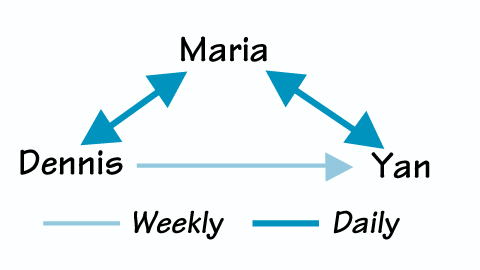
In this example, the social network data shows a relationship between Dennis, Maria, and Yan. Dennis and Maria, and Maria and Yan, have the strongest connections because they meet most frequently and share reciprocal interactions. At the same time, the relationship between Dennis and Yan is the weakest, because it is unidirectional and less frequent.
But we must be careful in making sweeping generalizations using social network graphs. For example, there can be value in weak ties. In our example, it could be that Dennis had valuable information that Yan needed to complete a work assignment. Our explanations of social network graphs must be validated by those involved in the study, which is again why the qualitative research is so important in preceding the social network survey.
Study of Social Network Graphs
Once the social network graph is constructed, it is shared with those participating in the study. This is a reflective process, as those involved in the network validate the quality of the data and in turn respond to its findings. Perhaps the study reveals that an important position is missing from the network, and participants take action to “fill the hole.” In response to another study, employees may choose to expand the number of connections within a social network; for example, a company that becomes more customer centered by shifting the structure of their social networks to include customers.
Following are some of the traditional features of social network graphics that can offer valuable information about their functioning and sources of leverage for change:
Density
Density is a measure of overall connectedness. It is arrived at by dividing the number of ties by the number of possible ties between people.
In this example, there are 5 ties between Maria, Peter, Dennis, and Katy out of 12 possible ties, so the density of this social network is .42. Density measures fall between 0 and 1.0, with 1.0 representing the greatest density or connectedness. The higher the density, the stronger the connections between team members. A low density score could potentially show conflict in the group or structural barriers that prevent members from communicating effectively.
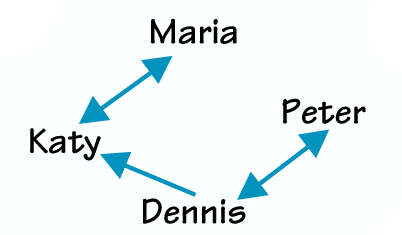
Centrality
Centrality is considered a measure of power, importance, or influence in social networks. It is derived simply by counting the number of connections a person has. In this example, Maria is the most “central” person in the network, followed by Chris and Darla, with Dennis, Katy, and Peter being the least central. Here again, we would rely on the qualitative interviews to learn more about Maria’s role. In some studies, we have found that the person in Maria’s position is a program manager that everyone depends on to keep them on track. Perhaps Maria is the supervisor of Dennis, Katy, and Darla and peer of Chris and Peter. In yet another context, Maria might be the creator of a rumor that is circulating about the office.
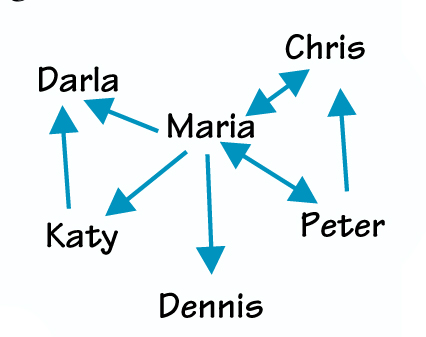
Structural Holes
When I use social network mapping as a learning process, those in the network construct and examine the maps themselves. Participants commonly observe structural holes — individuals missing from the diagram who have the potential to contribute to the network’s performance. In one case, a manager was called in to mitigate conflicts between Hewlett-Packard and a plastics supplier. He witnessed long, grueling meetings between the two organizations where little if anything was accomplished. The manager opened his journal and drew this picture representing the engineers in his organization and in the vendor’s organization:
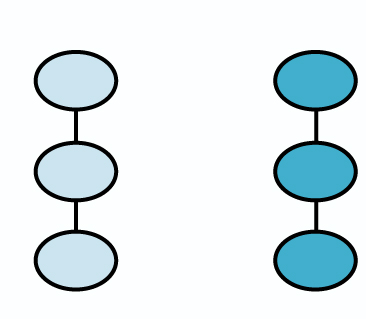
His sociogram showed connections within the organizations but more importantly showed structural holes between the two organizations. With engineers from both organizations present, the manager drew connections for all to see, suggesting that team members from both organizations should work as one team. As the age-old saying goes, a picture is worth a thousand words. In this case, quite literally the picture was worth thousands of dollars. Engineers from the two companies immediately began to fill the “holes” by collaborating, saving hundreds of thousands of dollars over the next year.
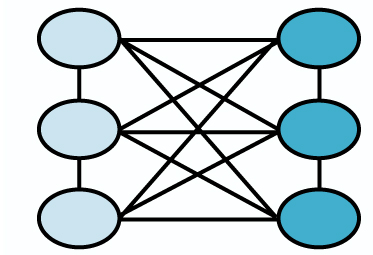
Social Systems and Living Systems
I have presented a number of traditional social network concepts. When looking at social network graphics, it is important to realize that, like photographs, they are snapshots of how social networks have formed. Social networks are constantly changing, and our greatest leverage lies in understanding them from a perspective of living systems. As currently practiced by many consultants using tools such as those described above, social network analysis is the separation of a social network into its component parts. It attempts to describe or make comments about an individual’s role within a network. So, going back to the social network in which Maria played a central role, an analysis might conclude that Dennis is an isolated “node” in the network and should be more of a team player. Or from a knowledge management perspective, Maria may be seen as a “hub” in the network and therefore should be promoted.
This approach can have value, but to me, it doesn’t go far enough in generating a systemic understanding of social networks. I have found that insights from the study of living systems and cognition provide the philosophical explanations for a deep understanding of social systems.
In 1951, social scientist Gregory Bateson reconceived psychiatric practices by describing a way of viewing the world that shifted from focusing on:
- parts to the whole,
- categorization to integration,
- the individual to interactions,
- systems outside the observer to systems that include the observer.
This shift was an initial step in leading us away from analysis and separation to systems thinking. But from my perspective, the most profound contributors to understanding social systems are the co-founders of the Matriztic Institute, Dr. Humberto Maturana and Professor Ximena Davila. They explain in great detail how human beings are born to collaborate and how we can move from a culture of pain and suffering to a culture of well-being through what they describe as “liberating conversations.” To me, this perspective offers new questions and insights into the value and practice of studying social networks. Based on their work, we begin our research with a simple statement: “Everything that is said is said by an observer.” We follow up with a fundamental question: “How do I do what I do as an observer of systems?”
This last question in particular is vital, because it brings forth the role of the observer in the social system they are reflecting upon. When someone interested in a particular network realizes that, whatever they do to the network, they do to themselves, too, they are likely to take socially responsible actions. In studying the work of Maturana and Davila, we also learn that social systems are dynamic and that anything that occurs in the social system is determined by its underlying structure.
Studying social systems is an important departure for organizations. Since the late 1800s, we have been accustomed to see organizations as machines. In the Industrial Age, the physical sciences became the frame of reference for guiding economic growth. Using scientific tools of separation, specialization, analysis, and reductionism, a new image of organizations emerged: the organizational, or org, chart. The org chart depicts hierarchy and areas of specialization. Although some still believe that organizations function based on the structures shown in these charts, many people are finding that the life sciences lead to a more valid understanding of social systems in organizations today. This shift in perspective raises new possibilities by leveraging the concepts of self-organization, collaboration, inter- and intra-organizational social networks, and multidimensionality.
Self-Organization
Are social networks static or dynamic? This is not a trivial question. Managing an organization’s effectiveness will depend on the answer to this question. If you believe that social networks are static, you will presume that relationships are always the same. If, however, you believe that social networks are dynamic, you will want to continually refresh your assumptions about how value is being created. Social action research or practices such as management by walking around become critical learning processes for understanding collective knowledge.
By mapping social networks over time, I have found that they are dynamic and constantly changing, even if the members stay the same. People self-organize as employees create new connections, weaken old connections, and so on in response to new opportunities. Self-organization is an important systemic principle, because performance and productivity are maximized as those within the social network have the freedom to organize their own relationships. You might think of self-organization as the antithesis of bureaucracy. Research has shown that the greatest reward for employees is making a timely contribution to their company, and self-organization is the group process for doing so. (See illustration above.)

Collaboration
Humans are social beings. We can pick out a familiar face among hundreds of pedestrians. At a very early age, infants recognize facial patterns. Biologically, facial recognition stimulates a neural network in the amygdala region of the mid-brain, which is also the center of our emotions. Neuroscientists claim that more than 90 percent of the information we receive from others we obtain through facial expression and body language. Unlike any other species, humans are neurologically wired to be social.
As Maturana and Davila have described, we humans are loving beings and are biologically structured to collaborate. This relationship of mutual acceptance expanded as humans formed groups to survive. Through this innate social behavior, we can accomplish tasks without having to spend time deciding on what group structure is most fitting. While companies spend a fortune on organizing their workforce, social systems require no funding or intervening because of their biological nature.
Social network structure varies. Some networks are based on command and control or dominant and obedient relationships. Other networks are distributive in nature, such as the rumor mill that exists in most organizations. Collaborative social networks are social systems in which everyone is accepted as a legitimate member by everyone else. They are cohesive and natural, and are the source of social capital or optimal group productivity. These systems are also the source of value creation, innovation, and performance breakthrough. This illustration shows optimal cohesion, as every member of the social network is connected to every other member in a seamless support system they created for a man with disabilities.
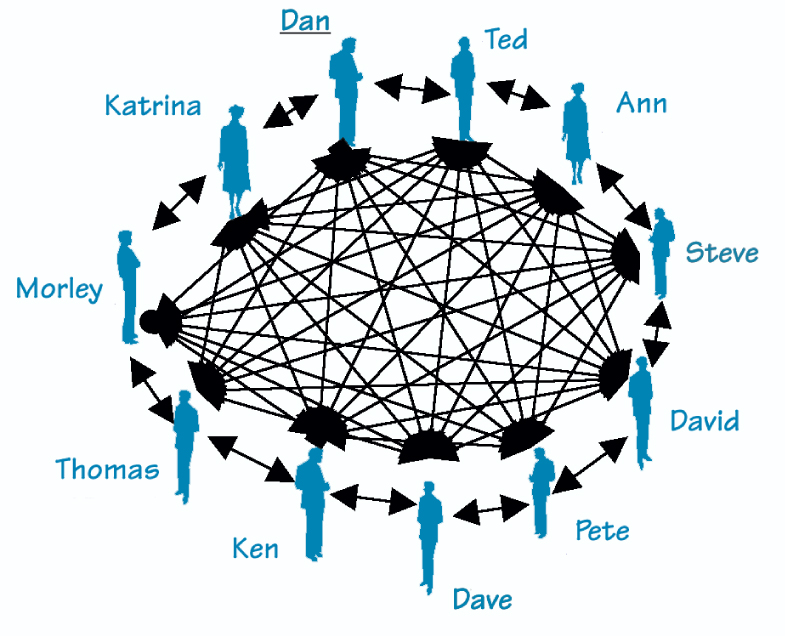
Whenever I have studied how value is created in the workplace, I have mapped collaborative social systems. In our expanding global economy, the performance challenge for executives is to create the conditions for collaboration to occur. Research has shown this can be done by (1) giving employees the freedom to organize themselves and (2) generating reflective conversations on how value is created.
Inter- and Intra-Organizational Social Networks

The theory that underlies most org charts is that work flows from the top of the organization down through the ranks. However, studies of how work actually gets done have consistently shown that it happens in social systems that span the organizational chart horizontally, not vertically. For a department in a large enterprise, I have plotted the collaborative social networks across the organization chart, shown above in blue shading.
The boundaries of value-creating social systems do not end within the organization. I have also studied collaboration in social systems that include two or more organizations. The rejection of plastics created by outside vendors for Hewlett-Packard’s inkjet cartridges was completely eliminated during the most aggressive inkjet cartridge launch in HP’s history, in part due to a collaborative network that included four Hewlett-Packard sites, two formerly competitive plastic suppliers, and subject matter experts. These parties worked closely in developing the use of transducers in plastic injection molding processes.
In another instance, in Puerto Rico, a network of HP engineers and engineers from their supplier Nypro joined forces on a project that refurbished worn manufacturing line parts instead of throwing them into local landfills. This network of collaboration had multiple effects. First, the initiative created social well-being by giving participants the freedom to innovate and the joy of accomplishment. Second, it generated biological well-being, as the factory no longer dumped heavy metals into Puerto Rico’s already taxed landfill waste dumps. Finally, it led to financial wellbeing by saving HP hundreds of thousands of dollars. You might recognize this example as the one cited earlier in the article in which the manager identified structural holes and asked engineers from both organizations to collaborate. In doing so, they saved HP more than $700,000.
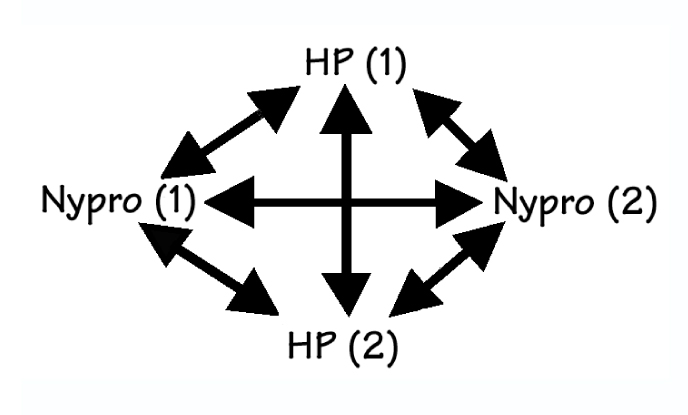
Multidimensionality
As social beings, we coordinate our actions in conversations within closed systems that include other business units, vendors, universities, family, and friends in a continuously changing present. This statement challenges our traditional thoughts of the org chart network, isolated internally and externally, as the source of value creation. In his 1982 book, Out of the Crisis, W. Edwards Deming drew an alternative value-production system as a network of suppliers->producers->consumers. In my work, I have found that our networks are multidimensional; for example, in the HP example cited above, those in the social system generated business results but also social and biological well-being.
The illustration at the bottom of page 5 shows the social system of people supporting a man with disabilities who grew up in a state institution. By providing this man with the support he needed to have a job, the network brought his productivity to 100 percent with perfect quality. In doing so, they improved his wages from $0 at the state institution to more than $1,500/month plus benefits, enabling him to leave welfare and public assistance. This shift allowed the man to move from the institution, which cost tax-payers $80,000/year, to his own community, where he became a taxpayer and owned his own condominium. His case is a prime example of how to leverage living, multidimensional, collaborative systems and, in the process, create value and well-being.
Systems Laws
The work of the Matriztic Institute goes a step further to describe systemic laws that can expand our understanding and application of social systems thinking.
Structural Determination
Imagine going to the stadium to watch your favorite sports team, or perhaps you are at a concert hall getting ready to listen to a symphony. You anticipate an extraordinary performance and then learn that an exemplary player has been replaced. Your immediate response may be incredulity. You may think, “How could they perform without this person?” If you do not find an adequate explanation for your question or if you aren’t satisfied with the substitute, you may become disappointed and critical.
Your disappointment in this instance stems from an innate understanding of the law of structural determination. As explained by Maturana and Davila, structural determination states that everything that occurs in a system is determined by the system’s structure. Engineers will immediately understand this concept. They are experts at developing new products as a system and making sure that the interconnected parts are structurally compatible. The same law can be applied to social systems, such as a team, an orchestra, or a workplace. In these settings, performance is determined by the structure of the social network. If critical people are missing, performance will suffer. If there is a lack of collaboration among members of the network, group productivity will diminish, and cost will increase. Emotions will turn from excitement to disappointment as participants and other stakeholders realize that the output may not be of the caliber they had anticipated.
These things often occur in the workplace through restructuring, reorganization, and voluntary workforce reductions. In one case, I mapped a social network that was generating new IT products. First one person and then two others were assigned new roles in the company. The executive in charge of the new IT products noticed a slowing of performance, and it took those remaining in the network months to reorganize their efforts. By understanding social network mapping and the systemic law of structural determination, executives can anticipate how changes to a network will affect its efficiency and overall performance.
Conservation
To exist in the rapidly growing global economy, companies are told they need to keep up with the competitive environment they find themselves in. New management concepts and abstractions are continually emerging to guide organizations through these complex, dynamic challenges. To capitalize on these innovative methodologies and perspectives, managers are told they must promote an internal culture of change. But the management literature tends to focus on new concepts instead of understanding how work is done.
I propose that managers must learn how value is created in our networked world. Although change is inevitable, it is equally important to conserve those practices that improve efficiency, value creation, and well-being in collaborative social systems. When initiatives inadvertently disrupt the network of relationships through which work is accomplished, they can backfire and leave the company even more vulnerable to outside pressures than before.
Research has shown that value is created in dynamic, collaborative social systems that connect people across business units, companies, continents, and cultures. To be successful in the global economy, organizations will need to develop new practices based on understanding social systems.
Although change is inevitable, it is equally important to conserve those practices that improve efficiency, value creation, and well-being in collaborative social systems.
Unfortunately, technological developments labeled as social networking can actually obscure our understanding.
The work of Humberto Maturana and Ximena Davila expands our knowledge of social systems. This knowledge will have positive effects on organizations of all kinds. First, by developing practices that support self-organizing social systems, managers will improve organizational efficiencies through productivity gains. Second, because the quality of our social systems translates to the quality of our knowledge, reflective studies of social systems will lead to financial, social, and biological well-being. Finally, as we reflect on our social nature, we discover that we too live our lives in social networks. Through this insight, we become socially responsible and generate greater social well-being.
Dennis Sandow is president of Reflexus Company, a research company studying performance and knowledge creation in collaborative social systems. Prior to starting Reflexus, Dennis conducted research on social networks and social capital at the University of Oregon. Dennis is a research member of the Society for Organizational Learning and lives in Oregon with his wife and two adult children.
NEXT STEPS
- Listening: Collaboration begins with listening, because we all like to be heard and recognized by others for our contribution. In true listening, one learns from others. Also, listening is key for accessing the flow of collective knowledge through an organization.
- Understanding: A consequence of listening with true interest is that you will be referred from person to person as you deepen your level of understanding. You’ll gain a hands-on experience with how people in the network collaborate. At the same time, the people in the network will understand that you understand them.
- Trusting: Trust is the silent connector in social networks. It grows when you know that others hear you and understand you. As trust grows, the focus shifts from me to we.
- Collaborating: Collaboration occurs when everyone in a network is accepted by everyone else as a contributor toward a shared purpose. In a high-trust environment, those in the network continually reflect on how they perform together and take action based on that evolving knowledge.
- Reflecting: Without reflection built into our work processes, we risk creating “busy-ness” that has no value. Rushing through tasks to check them off our lists does not increase our knowledge and understanding of what is important or how we can improve our performance and business value. Learning can occur only through group reflection on what we do, how we do it, what we value about our practices, and how we can improve them.
